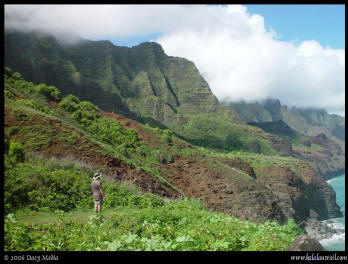 The Na Pali coast’s rugged and inspiring beauty is some of the most dramatic in the world. Na Pali is Hawaiian for “the cliffs,” the distinguishing and most impressive feature of this portion of coastline. The sheer cliffs dropping into the ocean below, hanging valleys and green slopping mountains make for some of the most spectacular scenery in Hawaii. Protected from intruders by the daunting cliffs in protected valleys, Na Pali was the first area of Kauai to be settled by early Hawaiians who chose the spot specifically for its remoteness and difficulty of access. The 18 miles of protected coastline remains one of the most remote areas in the islands. With no roads, the stretch of coastline is only accessible on foot or by boat. Na Pali is also home to pods of dolphins swimming off shore, humpback whales and sea turtles. Protected reefs provide some of the best snorkeling in the islands.
The Na Pali coast’s rugged and inspiring beauty is some of the most dramatic in the world. Na Pali is Hawaiian for “the cliffs,” the distinguishing and most impressive feature of this portion of coastline. The sheer cliffs dropping into the ocean below, hanging valleys and green slopping mountains make for some of the most spectacular scenery in Hawaii. Protected from intruders by the daunting cliffs in protected valleys, Na Pali was the first area of Kauai to be settled by early Hawaiians who chose the spot specifically for its remoteness and difficulty of access. The 18 miles of protected coastline remains one of the most remote areas in the islands. With no roads, the stretch of coastline is only accessible on foot or by boat. Na Pali is also home to pods of dolphins swimming off shore, humpback whales and sea turtles. Protected reefs provide some of the best snorkeling in the islands.
While the various zodiac and catamaran tours allow tourists to tour sea caves and see the awe-inspiring scenery from the ocean, adventurous travelers can see the Na Pali coast up close and personal by hiking the famous Kalalau Trail. The 11 mile trail etches into the cliffs that raise as much as 4,000 feet above the ocean below and crosses 5 major valleys and countless smaller ones. The sometimes-treacherous trail takes most experienced and fit hikers one day and many hikers two, who camp in a permitted spot along the way. The trail was first built in the late 1800s, with portions rebuilt in the 1930s. It is almost never level, and in some spots the trail is quite narrow along cliffs dropping hundreds or thousands of feet to the ocean below. In order to conserve and protect the delicate ecosystem, permits for hiking the trail and camping along the way are both limited and required, costing each camper $10 per day.
Part 1: Ke’e Beach to Hanakapi’ai (2miles)
This first portion of the trail is a poplar day hike for visitors who may want to experience the Kalalau trail, but do not want to make the 22-mile round-trip commitment. Permits are also not required for this first portion of the hike. It starts at Ke’e beach north of Hanalei on Kauai’s north shore and ends at Hanakapi’ai stream and beach. It is graded, but not the most difficult part of the trail. Swimming at either beach in this portion is not recommended as surf and rip currents are dangerous and can drown even experienced swimmers.
Part 2: Hanakapi’ai to Hanakoa (4 miles)
The most strenuous portion of the hiking begins at this section where switchbacks climb 800 vertical feet. The trail passes through several valleys and climbs to some of the highest points on the cliffs of the entire hike. Old agricultural terraces, which once grew taro and then coffee, can be seen during this portion of the hike. Wild mountain goats also call the cliffs and valleys home in this section of the trail. As hikers near Hanakoa stream, they will find 2 roofed shelters and a composting toilet. It is also were many hikers chose to spend their first night if completing the hike in two days.
Part 3: Hanakoa to Kalalau Beach (5 miles)
After the Hanakoa valley, the trail enters drier and more open land. This is also the portion of the trail notorious for its narrow sections in the cliffs with huge drop-offs to the ocean below. Hikers are advised to use extreme caution during these tricky sections. Upon reaching Kalalau beach, the hike is complete and hikers are allowed to camp behind the sand beach near the waterfall. There are also composting toilets located at this ending campsite. Permits will allow campers to stay here for 5 nights, but not more. Once again, hikers are urged to use extreme caution if swimming in the ocean here due to strong and unpredictable currents.